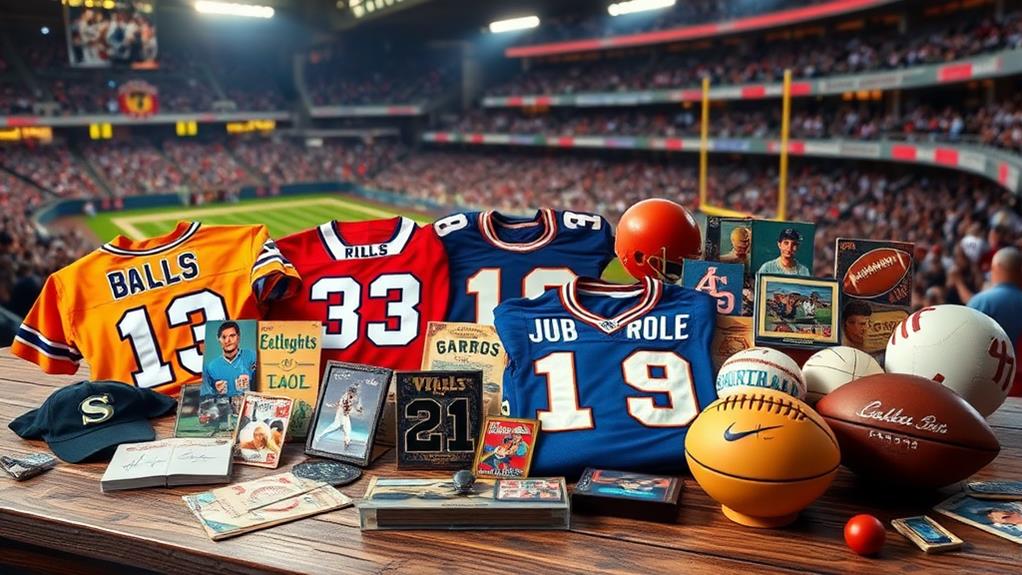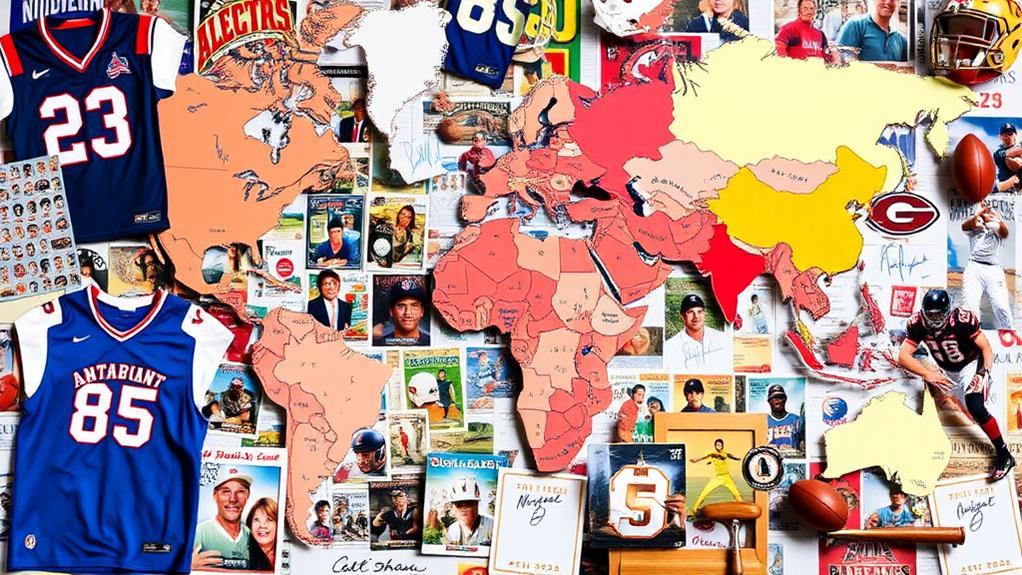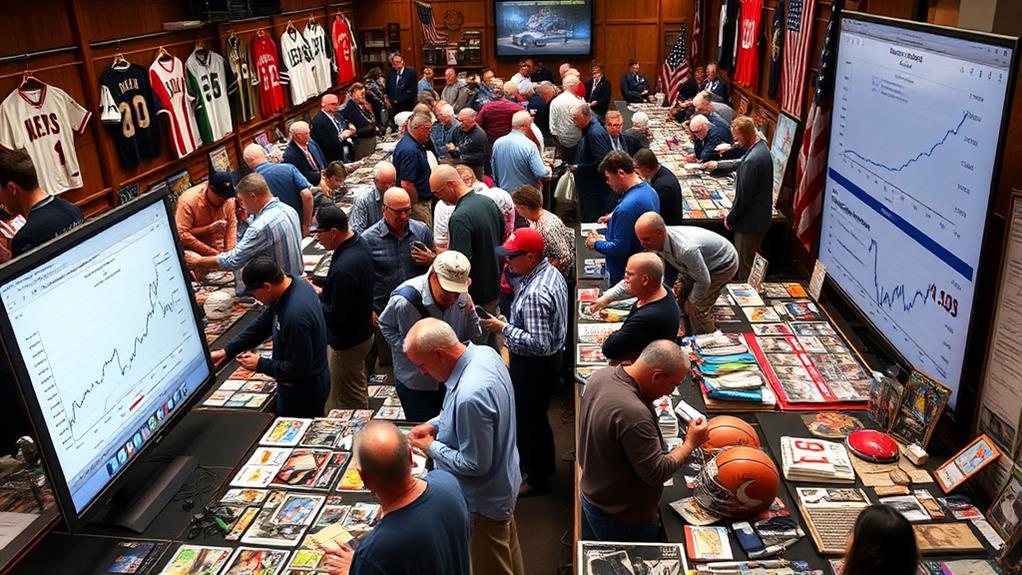The sports memorabilia and collectibles market is experiencing rapid growth, with a projected value of USD 52.62 million by 2032, up from USD 16.52 million in 2023. This growth is driven by fans' emotional connections to sports and the nostalgia they evoke. For instance, a jersey worn by a favorite player or a signed photo of a childhood hero can evoke strong feelings of nostalgia and pride.
Online platforms have made collecting sports memorabilia more accessible, allowing fans to browse and purchase items from anywhere in the world. Additionally, authentication services have been established to combat counterfeiting concerns, ensuring that collectors receive genuine items.
In terms of regional interest, North America leads the way, but global interest is rising sharply, particularly in Asia-Pacific and Europe.
As demand for unique items surges, the landscape is transforming, with new players entering the market and innovative business models emerging.
Market Overview and Size

Market Size and Growth
The sports memorabilia market is valued at USD 16.52 million in 2023 and is expected to reach USD 52.62 million by 2032, with a compound annual growth rate (CAGR) of 13.74%.
This growth is driven by the emotional connections fans have with their favorite teams and athletes.
Key Product Categories
The most coveted product categories include autographed jerseys, trading cards, and game-worn apparel, which are highly sought after by collectors eager to own a piece of sports history.
Regional Impact
North America plays a crucial role in the market's expansion due to its strong sports culture and significant consumer spending power.
The convenience of online marketplaces has made it easier for enthusiasts to buy, sell, and trade, further driving demand for unique and rare collectibles.
Market Opportunities
The sports memorabilia market offers an exciting opportunity for collectors to connect with their passion, whether they're seasoned collectors or newcomers intrigued by the allure of global sports memorabilia collectibles.
Market Trends and Dynamics
The sports memorabilia market is experiencing significant growth, driven by emotional connections and nostalgia. The market is expected to reach USD 52.62 million by 2032, with a compound annual growth rate (CAGR) of 13.74%. This surge in demand is fueled by fans' desire for autographed jerseys, trading cards, and game-worn items that evoke memories and emotions.
The rise of online marketplaces has made it easier for collectors to buy, sell, and trade memorabilia. Online platforms have greatly enhanced accessibility for collectors, allowing them to connect with a wider community and access a broader range of collectibles.
However, as demand increases, concerns over authenticity have also grown. Authentication and certification have become paramount, ensuring that collectors invest in genuine items. This emphasis on authentication is reflected in recent acquisitions, such as Fanatics Collectibles' purchase of PWCC Marketplace, which highlights the market's shift toward authenticated and hand-signed memorabilia.
Key trends shaping the sports memorabilia market include:
- Market Growth: Expected to reach USD 52.62 million by 2032
- Emotional Connections: Nostalgia drives demand for specific collectibles
- Online Marketplaces: Enhanced accessibility for transactions
- Authentication Focus: Increased emphasis on certified items
- Trading Cards Popularity: Sought after due to emotional ties
Geographic Market Insights

Geographic Market Insights
The sports memorabilia market exhibits distinct regional trends, with the Asia-Pacific region currently leading the collectibles market. This region's growth is driven by increasing disposable incomes, allowing individuals to invest in unique memorabilia. The enthusiasm for sports among consumers in this area contributes significantly to market expansion.
North America is projected to experience the highest compound annual growth rate (CAGR) from 2024 to 2032. This region's strong sports culture and substantial spending power foster a robust collector base that actively seeks out various memorabilia. For instance, the demand for autographed jerseys and game-used equipment is particularly high in this region.
In Europe, countries like the UK, Germany, and Italy are showing a rising interest in sports memorabilia. The growing collector base in this region is reshaping distribution channels, enhancing accessibility and availability of collectibles.
As a result, more collectors are now able to access rare and unique items.
Key Players in the Industry
Key Players in the Sports Memorabilia Industry
The sports memorabilia industry is driven by key players who are shaping its future through strategic initiatives and innovative offerings.
Industry Giants
Fanatics Collectibles has expanded its market presence by acquiring PWCC Marketplace, demonstrating its commitment to growth and consolidation.
The Topps Company, Upper Deck, Leaf Trading Cards, and Panini Group are established players focusing on product development and strategic growth initiatives to enhance their market presence.
Emphasis on Authenticity
Companies are prioritizing authentication processes to combat counterfeiting, ensuring collectors can trust their investments.
Authenticity Advocates are leading this effort, providing certified products that guarantee authenticity.
Market Growth and Future
The global sports memorabilia market is projected to grow from USD 16.52 million in 2023 to USD 52.62 million by 2032.
The competitive landscape will be influenced by partnerships, innovative product launches, and a focus on authenticity.
The role of key players becomes critical in navigating market growth and consumer trust, making the future of the sports memorabilia industry look promising.
How Does the Growth of the Sports Memorabilia Market Impact Corporate Sponsorships?
The growth of the sports memorabilia market has a significant impact on sports corporate sponsorships partnership. As the memorabilia market expands, it provides more opportunities for brands to connect with fans through sponsorships, leading to increased brand visibility and customer engagement within the sports community.
Challenges and Opportunities Ahead

The sports memorabilia industry is projected to grow significantly, from USD 16.52 million in 2023 to USD 52.62 million by 2032. This growth presents opportunities for collectors and investors, but also raises concerns about authenticity.
Counterfeiting remains a significant threat to authenticity. To combat this, there's a growing demand for enhanced tracking methods, such as blockchain technology, which can ensure the legitimacy of memorabilia.
The rise of digital collectibles and NFTs is revolutionizing ownership and fan engagement. For example, these digital items allow fans to explore new dimensions of memorabilia, such as interactive experiences and virtual ownership. This shift is pushing the industry towards valuing authenticated items, creating opportunities for businesses specializing in certification services.
The growing emphasis on authenticity can bolster investment value. As the industry prioritizes authenticated items, collectors and investors can benefit from the increased value of their investments.
Innovations like virtual reality experiences are enabling creative growth and deeper fan engagement. These experiences enrich the overall memorabilia experience, allowing fans to immerse themselves in their favorite sports and teams.
Future Outlook and Projections
The sports memorabilia industry is poised for remarkable growth, driven by factors catering to both nostalgia and collector demand.
Market Growth: The global sports memorabilia market is expected to grow significantly, from USD 16.52 million in 2023 to USD 52.62 billion by 2032, at a CAGR of 13.74%. This rapid expansion is driven by increasing demand for unique and rare collectibles.
The trading cards market is a significant contributor to this growth, projected to expand from USD 14.3 billion in 2023 to USD 51.3 billion by 2033. This surge is attributed to the nostalgic appeal and robust collector demand surrounding these items.
To combat counterfeiting issues, investment in authentication services will increase, boosting buyer confidence and making the market more attractive to serious collectors.
The entry of major players like Fanatics in 2026 is expected to reshape the industry landscape, driving significant revenue growth and industry expansion.
Questions and Answers
What Is the Future of Sports Memorabilia?
The sports memorabilia market is poised for growth, driven by increasing fan engagement and new technologies.
Trending athletes and vintage items are gaining value, making them attractive options for collectors. For example, items associated with popular athletes like LeBron James and Tom Brady are likely to appreciate in value over time.
Digital collectibles, such as NFTs, are expanding the market and providing new opportunities for collectors.
Platforms like NBA Top Shot and MLB Champions allow fans to buy, sell, and trade unique digital items, such as video clips and player cards. These digital collectibles are verified through blockchain technology, ensuring their authenticity.
Auction platforms are increasing accessibility and transparency in the market.
Websites like Heritage Auctions and Lelands provide a secure and trusted environment for collectors to buy and sell sports memorabilia. These platforms often feature items with provenance, which can increase their value.
Celebrity endorsements are driving interest and creating new collecting culture dynamics.
For instance, athletes like Steph Curry and Saquon Barkley have partnered with memorabilia companies to release exclusive items, such as autographed jerseys and game-used equipment. These partnerships can increase the value and appeal of these items.
As the market expands, collectors must navigate the authentication process carefully and develop smart investment strategies.
It is essential to research the provenance and authenticity of items before purchasing, and to consider factors like condition, rarity, and demand when making investment decisions.
Authentication is critical, and collectors should only purchase from reputable dealers and auction houses.
How Big Is the Sports Collectibles Industry?
The sports collectibles industry has experienced massive growth, driven by increasing interest in trending athletes and vintage cards. This growth is evident in the thriving memorabilia fairs and online auctions, where collectors showcase their passion.
Fan engagement drives demand, as enthusiasts seek unique items and experiences that bring them closer to their favorite athletes and teams. To ensure the value of these items, authentication services verify their authenticity, providing a level of assurance amidst market fluctuations.
Celebrity endorsements also enhance the appeal of sports collectibles, with famous athletes and influencers promoting specific items or brands.
Furthermore, the historical significance of items adds depth, as rare and vintage collectibles provide a tangible connection to sports history.
Is Collecting Sports Memorabilia a Good Investment?
Collecting sports memorabilia can be a profitable investment if done strategically. To succeed, it's essential to stay informed about market trends and understand collector demographics.
For instance, popular items like trading cards can fetch high prices at auction houses, especially when graded by reputable services like Professional Sports Authenticator (PSA) or Beckett Grading Services (BGS). These grades verify the item's authenticity and condition, increasing its value.
Long-term value and emotional satisfaction are potential benefits of collecting sports memorabilia. However, it's crucial to understand investment risks, such as market fluctuations and the possibility of fake or tampered items.
Seeking expert opinions can guide your investment choices, ensuring you make informed decisions about pieces that will resonate with both nostalgia and future demand.
Does Sports Memorabilia Increase in Value?
Yes, sports memorabilia can increase in value significantly. This is because items like vintage cards and signed player jerseys often appreciate due to their autograph authenticity and connection to iconic moments. For instance, a signed jersey from a legendary player like Michael Jordan can increase in value over time due to its rarity and demand.
Engaging with collector communities and utilizing grading services like Professional Sports Authenticator (PSA) or Beckett Grading Services (BGS) can enhance the value of your investment. These services verify the authenticity of autographs and provide a grade based on the item's condition, which can increase its value.
Market trends play a significant role in determining the value of sports memorabilia. Keeping an eye on market trends and participating in memorabilia auctions or online marketplaces like eBay or Heritage Auctions can help you capitalize on demand. For example, if a player is having a remarkable season, their memorabilia may increase in value due to increased demand.